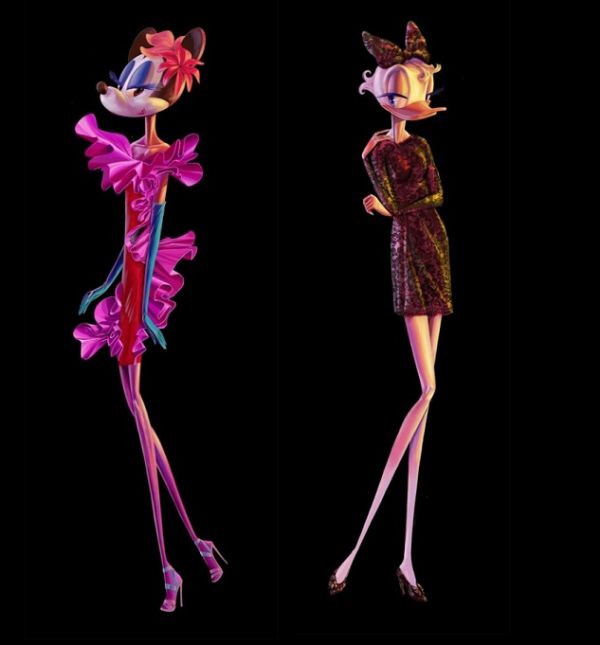Lydia Belden doesn’t want a skinny Minnie.
The 17-year-old high school senior from Cape Elizabeth wants the Minnie Mouse she loved as a preschooler, the round little mouse who was cute and funny and made her feel good about herself.
She cringed when she heard this week that Barneys New York, a high-end clothing store, had created leggy supermodel versions of Minnie and other Disney characters for its annual holiday window display and ad campaign.
“Those characters, like Minnie Mouse, were a key part of my life growing up, so to see this happening to them is upsetting,” said Lydia. “They shouldn’t make them into something girls can’t live up to. By doing this, they sort of destroy the happy image we had of them as kids.”
Lydia’s mother, Anne Belden, is board president of a Maine-based girls’ activism group called Hardy Girls Healthy Women. When she heard about the plan to glamorize Minnie Mouse, Daisy Duck and other Disney characters, she worried that it continues a marketing trend of trying to steer young girls toward a certain look, and a certain body image — and the products that go along with them — as they get older.
“It’s another example of trying to give our kids a message that there’s an ideal body image they should aspire to, but it’s so limiting and distorting to do that,” said Belden, who works as a coach for couples dealing with infertility and adoption. “What does it say about our culture that we have to morph the bodies of cartoon characters for marketing purposes?”
The Beldens echoed the outrage of people across the country after Barneys and Disney announced Wednesday that Disney characters would be redrawn as runway models for a short film and “moving art” piece that will be the centerpiece of Barneys’ holiday window display at its Madison Avenue store, beginning in mid-November.
Images of Disney characters will also appear on Barneys shopping bags, but it’s unclear whether they will be the runway model versions. Barneys spokesmen said they would not release more information, other than the original news release, until the holiday window display opens Nov. 14.
Much of the controversy over Minnie and friends was fueled by pictures released by Barneys to Women’s Wear Daily, showing Minnie and Daisy supermodel thin, with super-short skirts and frilly frocks. By Thursday, they were all over the Internet and TV news shows.
In a news release, Barneys said the centerpiece of its window display will be the “moving art” film featuring Disney characters that become part of a “fantasy” Paris runway show and are transformed into “fashion-forward” models wearing the latest designer garb.
Disney is apparently happy with the arrangement. Bob Chapek, president of Disney Consumer Products, said in a statement that the Barneys display and campaign “is a festive extravaganza that will delight people of all ages.”
But parents and girls don’t seem delighted, especially those who are already weary of marketing that seems aimed at convincing girls — from a very young age — that there is only one way for girls to look, and act.
“It strikes me as this kind of cradle-to-grave brand loyalty, where they’re trying to connect little girls to the cuteness of Minnie Mouse, and then carry that connection along so that as the girls get older the character leads them to a certain fashion or look,” said Lyn Mikel Brown, an education professor at Colby College in Waterville and a founder of the national girls’ activism group SPARK Movement.
Brown researched the effects of marketing on girls as co-author of the book “Packaging Girlhood: Rescuing Our Daughters from Marketers’ Schemes.”
A member of SPARK Movement — 14-year-old Julia Bluhm of Waterville — started a petition in April that eventually helped convince editors at Seventeen magazine to stop using altered photos of girls’ bodies or faces. The petition on Change.org drew more than 84,000 signatures.
Even Mainers who work in fashion don’t think it’s a great idea to turn Minnie and friends into thinner versions of themselves, for the sake of fashion.
Ashley Lauren Kerr, a Scarborough-based dress designer who does pageant preparation work, said Barneys would have done better to keep Minnie her recognizable self, and let designers create sketches that fit her proportions.
She pointed out that another iconic children’s character — Miss Piggy — had a fashion shoot last year in InStyle Magazine. For that spread, Miss Piggy kept her famous figure, and designers created clothes to fit her. That approach makes more sense to Kerr than what Barneys is doing.
“You have so many celebrities who are curvy, who are redefining fashion, so I’m not sure why they just didn’t have designers sketch clothes that fit Minnie the way she is,” said Kerr. “I think then they’d have a campaign more people could relate to. The way they have it now, you don’t really recognize the characters.”
Staff Writer Ray Routhier can be contacted at 791-6454 or at:
rrouthier@pressherald.com
Send questions/comments to the editors.




Success. Please wait for the page to reload. If the page does not reload within 5 seconds, please refresh the page.
Enter your email and password to access comments.
Hi, to comment on stories you must . This profile is in addition to your subscription and website login.
Already have a commenting profile? .
Invalid username/password.
Please check your email to confirm and complete your registration.
Only subscribers are eligible to post comments. Please subscribe or login first for digital access. Here’s why.
Use the form below to reset your password. When you've submitted your account email, we will send an email with a reset code.